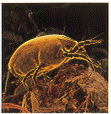| Air Filters Air Cleaners Air Purifiers Refills Chemicals Space-Gard Air Bear
|
|

Dust Mites
"One of the most highly allergenic contaminants found indoors"
One of the most highly allergenic contaminants found indoors is house dust, often heavily contaminated with the fecal pellets and skins of House Dust Mites. Estimates are that dust mites may be a factor in 50 to 80 % of asthmatics, as well as in countless cases of eczema, hay fever, and other allergic ailments. Common causes of allergy include house dust mites, cat dander, cockroach droppings and grass pollen.
Symptoms
Are respiratory in nature, usually not a rash. However, there are reports of a red rash around the neck. The wheeze-inducing proteins are digestive juices from the mite gut and are potent. An exposure to the mites in the first year of a infants life can trigger a lifelong allergy.There is no cure, only prevention. One must control the levels of dust mites. Beds are a prime habitat, a typical mattress may have anywhere from 100,000 to 10 million mites inside. Mites prefer warm, moist surroundings such as the inside of a mattress when someone is on it. Their favorite food is dander (human skin flakes), also, bedroom carpeting and household upholstery support high mite populations. Dust mites, due to their very small size (250 to 300 microns in length) and translucent bodies, are not visible to the unaided eye. For accurate identification, one needs at least 10X magnification. Through a microscope, one will see many oval-shaped mites scuttling around and over one another. There are eight hairy legs, no eyes, no antennae, a mouthpart group in front of body (resembles a head) and a tough, translucent shell, giving a "fearsome appearance".
Control Measures
Recommendations focus on "dust control". One must reduce the concentrations of dust borne allergens in the living environment by controlling both allergen production and the dust which serves to transport it.For further details please e-mail us: info@airfilters.net
Keep the house clean Dust mites, pollens, animal dander, and the allergy causing agents can be reduced, although not eliminated through regular cleaning Use a good vacuum. Most vacuums actually cause the problem to worsen because the filter bags in most models are not efficient and cause allergen levels to rise. Keep humidity levels below 60 percent. Dust mites as well as other allergens thrive on high humidity. Homes with air conditioning constantly have lower mite counts then non-air conditioned homes. Use a good air filter Most store bought air filters an not capable of trapping mites and their by-products. One should also look for a filter that has anti-microbial properties, to prevent the filter from becoming a breeding ground for allergens. Filters that call themselves "washable" should be avoided because it just is not possible to wash 100% of the biological contaminants out of them and they will also become a breeding ground.



